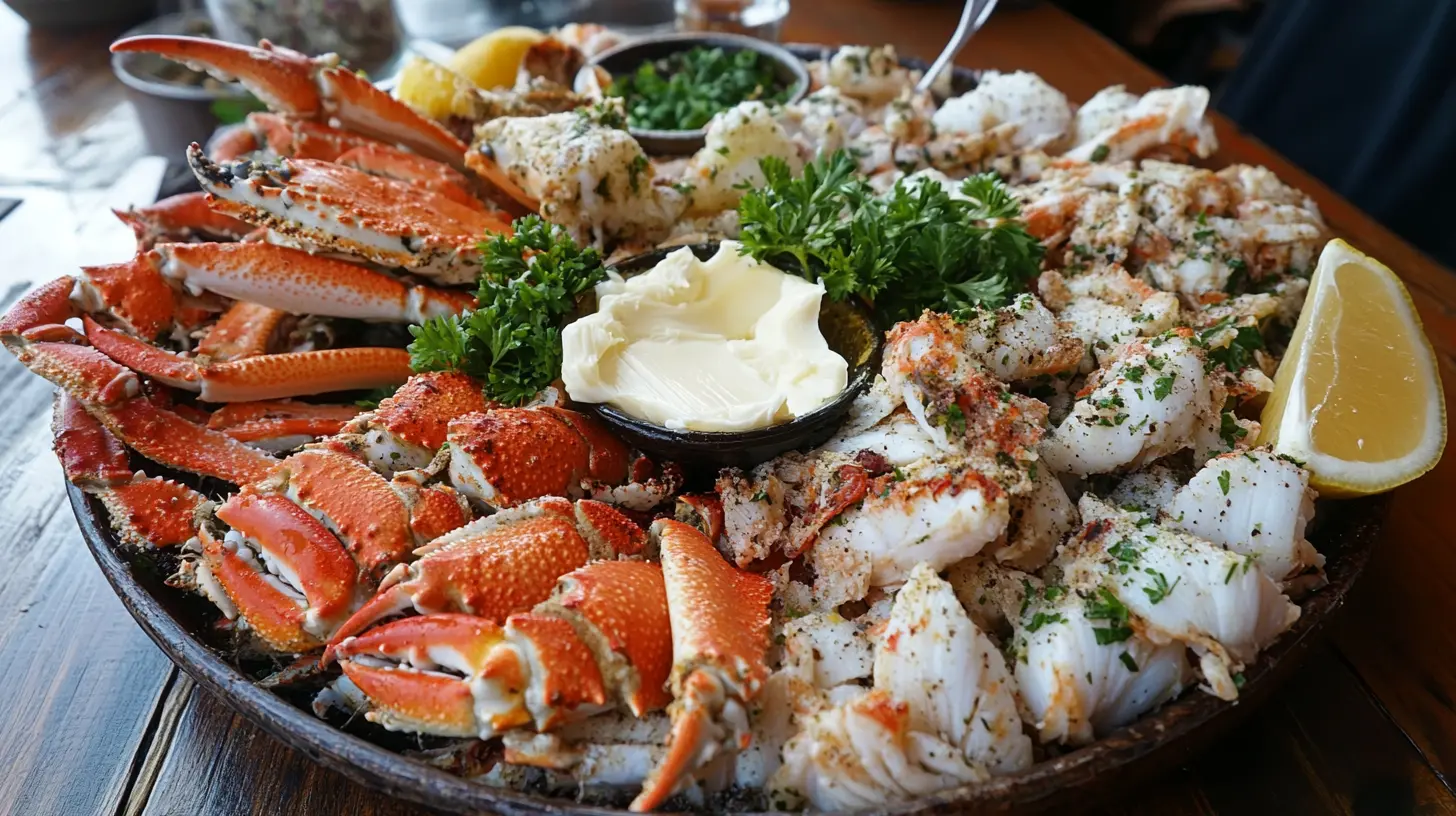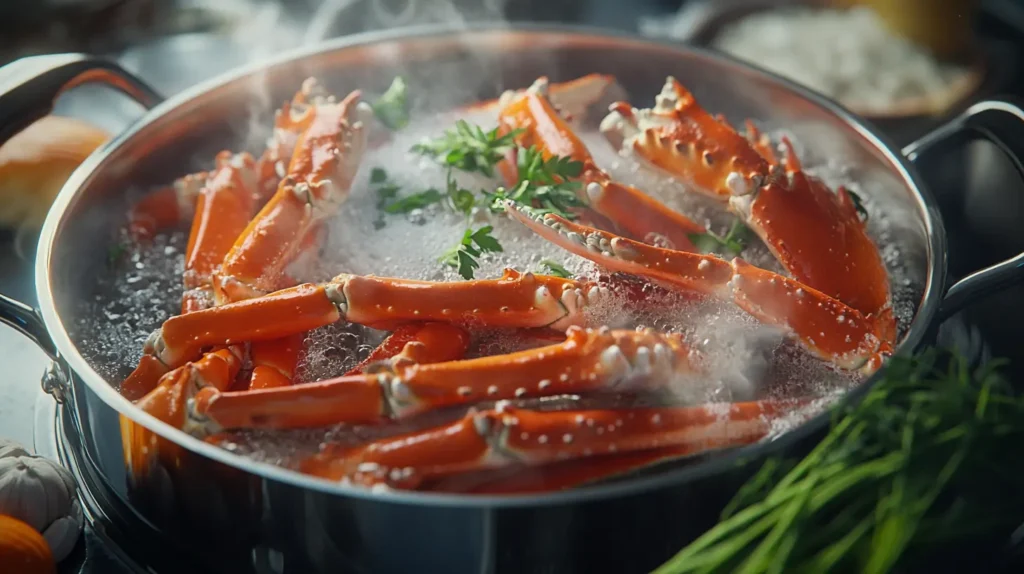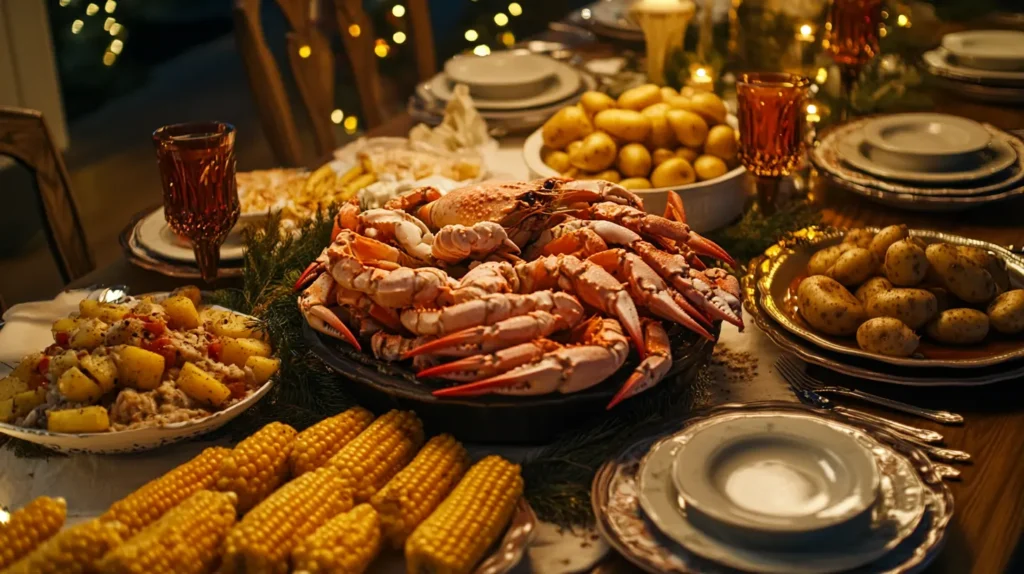Last updated on: January 8, 2025

Introduction
Seafood lovers, rejoice! One of the most beloved treasures from the sea, snow crab clusters, is a delicacy that satisfies both the taste buds and the need for a healthy, protein-rich meal. These delectable clusters, filled with sweet, tender meat, are a staple in seafood boils, fancy dinners, and even quick weeknight meals. In this article, we’ll dive deep into what makes snow crab clusters so popular—from their origins and nutritional benefits to cooking tips and recipe ideas. If you’re curious about how to choose the best clusters or need tips on preparing them to perfection, you’re in the right place!
Let’s get cracking—pun intended! 🦀
What Are Snow Crab Clusters?
Understanding what snow crab clusters are and why they’re so popular is the first step to appreciating this seafood delight. Let’s explore where they come from and what makes them unique.
Definition of Snow Crab Clusters
Snow crab clusters refer to a section of the crab’s body that includes legs and a portion of the crab’s body where the legs are attached. A typical cluster usually contains four legs and one claw, making it a satisfying serving size for seafood enthusiasts.
The meat inside these clusters is known for its sweet, delicate flavor and tender texture. Unlike other types of crabs, snow crab meat is easy to extract, making it a convenient choice for meals and seafood platters.
Origin and Habitat of Snow Crabs
Snow crabs are native to the cold waters of the North Atlantic and North Pacific Oceans. They thrive in icy environments, typically found in the depths of the Bering Sea, Alaska, and Canada.
These crabs get their name from their snowy-white appearance when cooked. Their natural habitat contributes to their sweet flavor and firm meat, which makes them stand out from other crab species like the blue crab or king crab.
How Snow Crab Clusters Are Harvested
Snow crab harvesting is a carefully regulated process to ensure sustainability and protect marine ecosystems. Fishermen use specialized crab traps called pots to catch these crabs without damaging the ocean floor or harming other marine life.
Once caught, the crabs are processed quickly—most snow crab clusters you find in stores are precooked and flash-frozen to preserve their flavor and texture. This means they’re ready to eat with just a bit of reheating!
Popular Types of Snow Crab Clusters Available in the Market
There are different grades and sizes of snow crab clusters available, depending on where you shop. Here are the most common types:
- Large Snow Crab Clusters: These typically weigh around 10-12 ounces per cluster and are packed with sweet meat.
- Jumbo Snow Crab Clusters: The biggest and meatiest clusters, often weighing over 12 ounces per piece. Perfect for seafood feasts!
- Frozen Snow Crab Clusters: Sold in bags or boxes, these clusters are precooked and need minimal preparation.
In most grocery stores or seafood markets, you’ll find snow crab clusters sold by weight, often in 2-lb or 5-lb packages. Look for clusters with bright, clean shells and avoid any that look dull or damaged.
How to Cook Snow Crab Clusters

Cooking snow-crab clusters is surprisingly simple. With just a few methods and a handful of ingredients, you can whip up a seafood dish that’ll impress your guests and satisfy your cravings. Let’s dive into the best cooking techniques and tips to ensure your crab clusters turn out perfectly every time.
Different Cooking Methods for Snow Crab Clusters
There’s more than one way to cook snow crab clusters, but the key is to keep it simple to preserve their sweet, delicate flavor. Here are the most popular methods:
- Steaming: Arguably the best way to retain the flavor and texture. Simply place your clusters in a steam basket over boiling water for about 4-6 minutes.
- Boiling: A quick method, though it can slightly dilute the flavor. Boil the clusters for about 4-5 minutes until heated through.
- Grilling: This adds a smoky twist to the sweet crab meat. Brush your clusters with garlic butter and grill for 3-4 minutes per side.
- Baking: Wrap the clusters in foil with seasoning and bake at 375°F for 12-15 minutes.
When preparing snow crab clusters, remember that most are sold precooked, so you’re just reheating them.
Step-by-Step Guide to Steaming Snow Crab Clusters
Steaming is a foolproof way to get the best flavor out of your clusters. Here’s a step-by-step guide:
- Prepare a large pot: Fill it with about 2 inches of water. Bring it to a boil.
- Place the clusters in a steamer basket: Arrange them in a single layer to ensure even heating.
- Cover and steam: Once the water is boiling, cover the pot and steam the clusters for 5-6 minutes.
- Serve with butter: Melted garlic butter pairs beautifully with the sweet meat.
Common Mistakes to Avoid When Cooking
Even experienced cooks can make mistakes when preparing crab. Avoid these common pitfalls:
- Overcooking: Since snow crab clusters are pre-cooked, you only need to heat them through. Overcooking can make the meat tough.
- Skipping seasoning: While the crab itself is sweet, a sprinkle of Old Bay or Cajun seasoning can enhance the flavor.
- Using too much water: When boiling, ensure you don’t submerge the clusters for too long to avoid waterlogged meat.
Nutritional Benefits of Snow Crab Clusters
Seafood isn’t just delicious; it’s also incredibly nutritious. Snow crab clusters offer a range of health benefits that make them a great addition to your diet.
Protein and Omega-3 Content
Snow crab clusters are a fantastic source of lean protein, essential for muscle growth and repair. A single cluster provides around 20 grams of protein, making it a satisfying meal for fitness enthusiasts.
Additionally, snow crabs are rich in Omega-3 fatty acids, which promote heart health, reduce inflammation, and support brain function.
Low-Fat and Low-Calorie Seafood Options
Unlike red meat, snow crab clusters are low in fat and calories. A 3-ounce serving contains approximately 98 calories and less than 2 grams of fat, making it an excellent choice for those watching their weight.
Craving more low-fat meal ideas? Check out this healthy yogurt guide for more inspiration.
Essential Vitamins and Minerals in Snow Crab Clusters
Snow crab meat is packed with essential vitamins and minerals, including:
- Vitamin B12: Supports nerve function and helps create red blood cells.
- Zinc: Boosts your immune system and promotes wound healing.
- Magnesium: Important for muscle and nerve function.
Adding snow crab clusters to your meals is an easy way to boost your intake of these crucial nutrients while enjoying a delicious seafood feast.
How to Choose the Best Snow Crab Clusters
Choosing the right snow crab clusters is crucial to ensure you get the best quality and taste for your seafood dishes. Whether you’re buying them fresh or frozen, here are some tips to help you pick the best clusters for your next meal.
Differences Between Fresh, Frozen, and Pre-Cooked Clusters
When shopping for snow crab clusters, you’ll likely come across fresh, frozen, and pre-cooked options. Here’s how they differ:
- Fresh Snow Crab Clusters: These are typically available in coastal areas and must be cooked immediately. They offer the freshest flavor but have a shorter shelf life.
- Frozen Snow Crab Clusters: The most common option found in supermarkets. These clusters are precooked and flash-frozen to preserve their flavor and texture.
- Pre-Cooked Clusters: Sold frozen and ready to eat after a quick reheat. They’re convenient and perfect for quick meals.
Most people opt for frozen clusters because they’re easy to store and prepare. Just thaw, heat, and enjoy!
Tips for Identifying High-Quality Frozen Crab Clusters
To ensure you’re getting the best snow crab clusters, keep the following tips in mind:
- Check the Shell: Look for clusters with a bright, reddish-brown shell. Dull or discolored shells can be a sign of aging or poor handling.
- Inspect for Cracks: Avoid clusters with cracked or broken legs. Intact shells help keep the meat fresh and flavorful.
- Look for Ice Crystals: If there’s too much ice on the cluster, it might have been thawed and refrozen, which can affect the meat’s texture.
- Smell Test: High-quality clusters should smell fresh and briny, not fishy or off-putting.
Where to Buy Snow Crab Clusters
You can find snow crab clusters at most grocery stores, seafood markets, and online retailers. When buying online, choose reputable seafood suppliers that guarantee freshness and sustainable harvesting practices.
For more seafood buying tips, you might find Totally Foodie’s Wagyu Beef Guide helpful in learning how to choose premium cuts of meat, whether on land or sea!
Frequently Asked Questions
Got questions about snow crab clusters? You’re not alone! Here are answers to some of the most frequently asked questions to help you better understand and enjoy this seafood delight.
What Is a Snow Crab Cluster?
A snow crab cluster refers to a section of a crab’s body, including several legs and a claw, all attached to a portion of the shell. These clusters make it easy to enjoy crab meat without needing to crack an entire crab.
The meat in a snow crab cluster is sweet and tender, perfect for dipping in butter or adding to seafood dishes.
What Is the Difference Between Snow Crab Clusters and Crab Legs?
The terms snow crab clusters and crab legs are often used interchangeably, but there’s a slight difference:
- Snow Crab Clusters: These include a portion of the crab’s body along with attached legs and a claw. They provide more meat in one serving.
- Crab Legs: These are usually sold separately and contain only the legs, without the body portion.
Clusters are ideal for a hearty meal, while crab legs are often used for appetizers or smaller servings.
How Many Clusters Are in 1 lb of Snow Crab Legs?
The number of snow crab clusters per pound depends on their size. On average:
- Small Clusters: 2-3 clusters per pound
- Large Clusters: 1-2 clusters per pound
Keep in mind that weight can vary depending on whether the clusters are fresh or frozen.
Are Snow Crab Clusters Fully Cooked?
Yes, most frozen crab clusters sold in stores are fully cooked and frozen. They are precooked shortly after harvesting to preserve their flavor and texture.
All you need to do is thaw and reheat them. It’s that simple!
What is a snow crab cluster in the box?
A snow crab cluster refers to a section of the snow crab that typically includes a portion of the body and all the attached legs, including the claw. When you purchase a “snow crab cluster in the box,” it usually means the cluster has been pre-packaged and sold in a box, often frozen or chilled, ready for cooking or consumption. This packaging method is popular for its convenience and the quality preservation of the crab meat.
For more seafood tips and recipe ideas, check out Totally Foodie’s Crab Brulee Recipe to explore unique ways to enjoy crab!
Recipe Ideas

Whether you’re hosting a seafood boil, preparing a family dinner, or just looking to treat yourself, snow crab clusters make a versatile ingredient for a variety of dishes. Here are a few recipe ideas that bring out the best in this delicious seafood.
Classic Crab Boil with Snow Crab Clusters
A traditional seafood boil is one of the most popular ways to enjoy snow crab clusters. It’s simple, flavorful, and perfect for feeding a crowd.
Ingredients:
- 2 lbs of snow crab clusters
- 1 lb of shrimp
- 1 lb of sausage (sliced)
- Corn on the cob (cut into pieces)
- Red potatoes
- Old Bay seasoning
- Lemon wedges
- Butter
Instructions:
- Fill a large pot with water and bring it to a boil.
- Add potatoes, corn, and sausage. Season generously with Old Bay.
- After 10 minutes, add shrimp and snow crab clusters. Cook for another 4-6 minutes.
- Drain the pot and serve everything on a large platter with melted butter and lemon wedges.
This crab boil is a guaranteed crowd-pleaser that’s bursting with flavor!
Garlic Butter Snow Crab Clusters
For a quick and easy meal, try this garlic butter recipe that enhances the natural sweetness of snow crab clusters.
Ingredients:
- 2 lbs of snow crab clusters
- 4 tbsp of butter
- 3 cloves of garlic (minced)
- 1 lemon (juiced)
- Parsley for garnish
Instructions:
- Melt butter in a pan over medium heat.
- Add garlic and cook until fragrant.
- Place the snow crab clusters in the pan, spoon the butter mixture over them, and cook for 4-5 minutes.
- Squeeze lemon juice over the clusters and garnish with parsley.
Serve with crusty bread to soak up the flavorful garlic butter!
For more seafood-inspired meals, check out Totally Foodie’s Crab Brulee Recipe for a creative twist on crab dishes.
Sustainability and Ethical Considerations
When enjoying snow crab clusters, it’s important to think about sustainability. Overfishing and environmental damage are real concerns in the seafood industry, but there are ways to make responsible choices when purchasing your seafood.
Sustainable Fishing Practices for Snow Crabs
Snow crabs are harvested using crab pots, which are designed to minimize bycatch (accidentally catching other marine species). Many fisheries follow strict regulations to ensure crab populations remain healthy and stable.
Look for snow crab clusters labeled as sustainably sourced or certified by organizations like the Marine Stewardship Council (MSC). This ensures the seafood you’re buying was harvested in an environmentally friendly way.
How to Support Sustainable Seafood Choices
As a consumer, there are a few ways you can support sustainable seafood practices:
- Buy from reputable suppliers: Choose brands that prioritize sustainability and ethical harvesting practices.
- Check for certifications: Look for sustainability labels like MSC or Ocean Wise.
- Avoid waste: Use every part of the crab cluster to reduce food waste. Crab shells can even be used to make flavorful seafood stock!
By making informed choices, you can enjoy your snow crab clusters guilt-free while supporting the environment and the future of seafood harvesting.
Fun Facts and Trivia About Snow Crab Clusters
Did you know that snow crab clusters have a fascinating history and cultural significance? From record-breaking catches to unique names, these crabs have a story as interesting as their flavor. Let’s dive into some fun facts that’ll make you appreciate your next seafood feast even more.
The Largest Snow Crab Ever Caught
One of the most impressive snow crabs ever recorded weighed over 20 pounds and had a leg span of more than 5 feet! Most snow crabs you’ll find in stores are much smaller, but it’s amazing to think about these giants lurking in the cold waters of the North Atlantic.
Fishermen often refer to particularly large snow crabs as “colossal,” and they’re a rare and prized catch in the seafood industry.
Why Snow Crabs Are Also Known as “Queen Crabs”
You’ve probably heard of king crabs, but did you know that snow crabs are sometimes called “queen crabs”? The nickname comes from their smaller size compared to the hefty king crab. However, many seafood lovers prefer snow crab clusters because they’re easier to crack open and have a sweeter, more delicate flavor.
Interestingly, their name isn’t related to snow but rather to their white meat and snowy appearance once cooked.
Conclusion – Why Snow Crab Clusters Deserve a Spot on Your Plate
After exploring everything from how to cook snow crab clusters to their sustainability and fun facts, it’s clear why this seafood delicacy has such widespread appeal. They’re versatile, nutritious, and, most importantly, incredibly delicious.
Whether you enjoy them in a classic seafood boil, drizzled with garlic butter, or grilled for a smoky twist, frozen crab clusters offer a quick and satisfying meal that’s easy to prepare. With their low-calorie count and high protein content, they’re also a healthy choice for anyone looking to add more seafood to their diet.
Moreover, choosing sustainably sourced clusters ensures you’re supporting responsible fishing practices that protect our oceans. It’s a win-win for both your taste buds and the planet!
In the end, snow crab clusters are more than just a meal—they’re a way to bring people together around a shared love of seafood. So, next time you’re planning a dinner, don’t forget to add these sweet, tender clusters to your menu. You won’t regret it!

